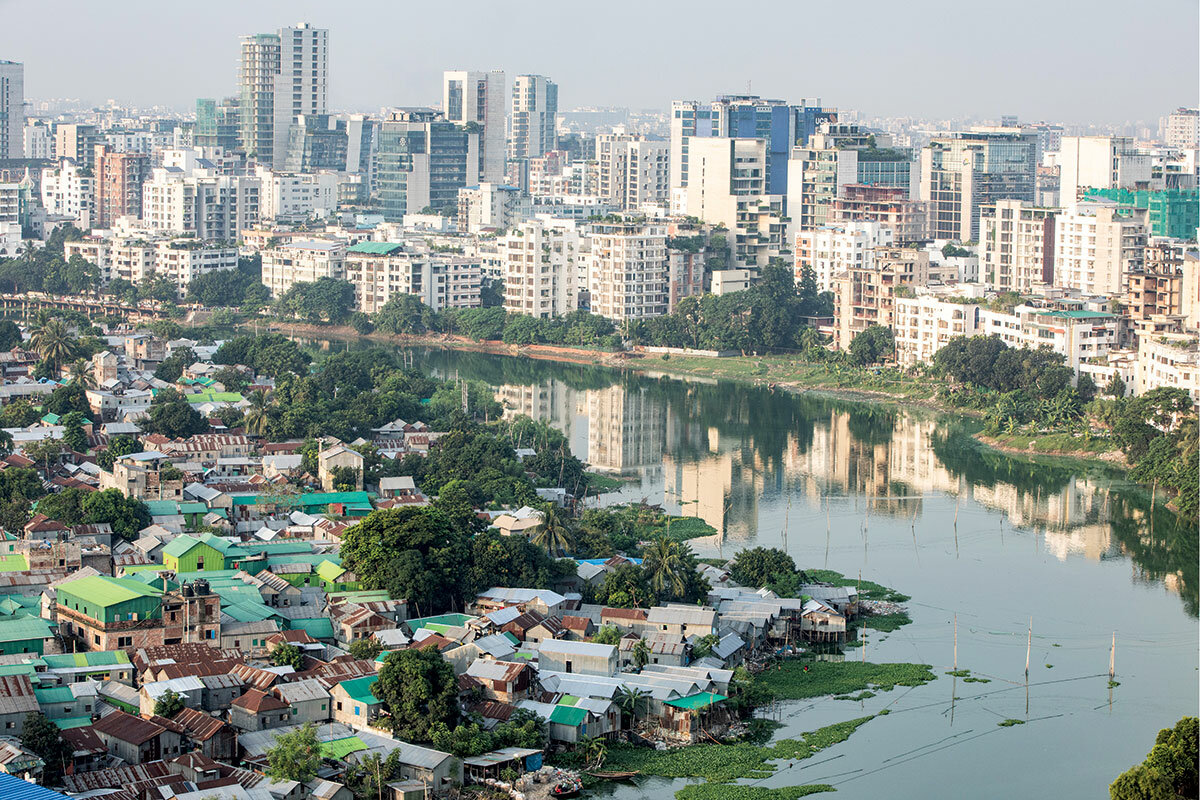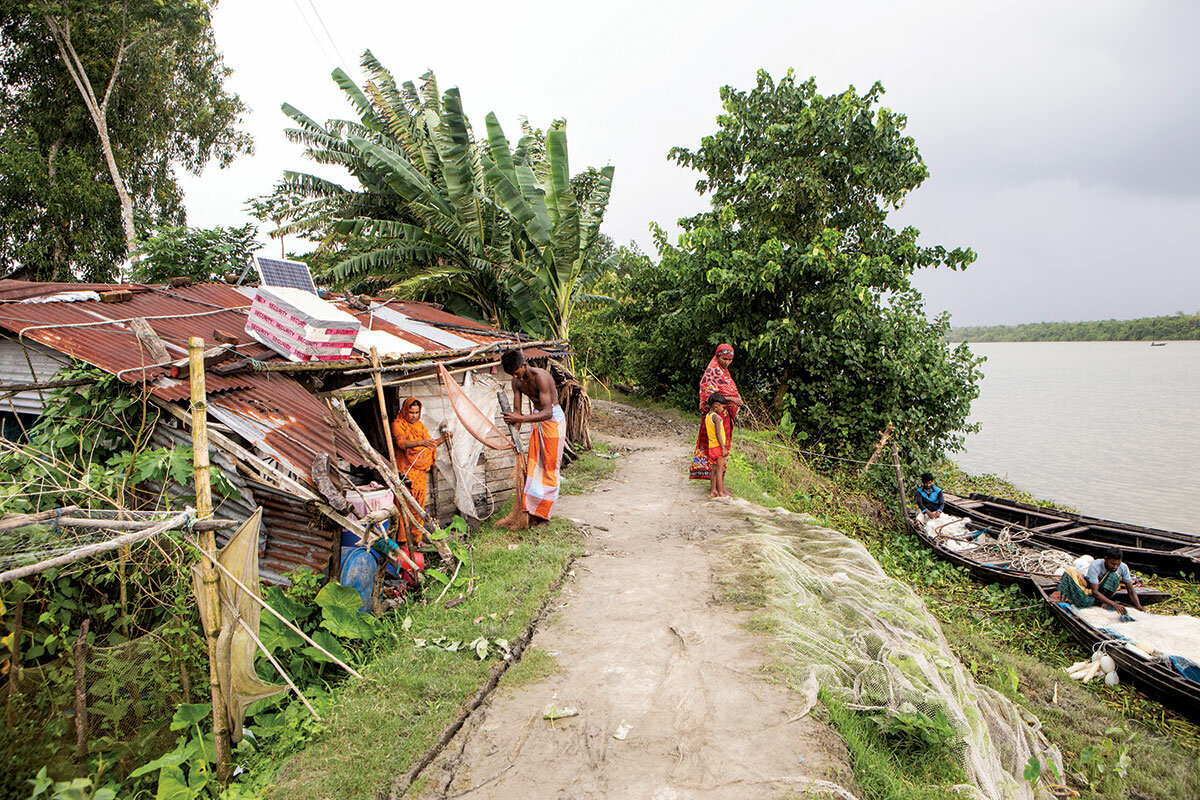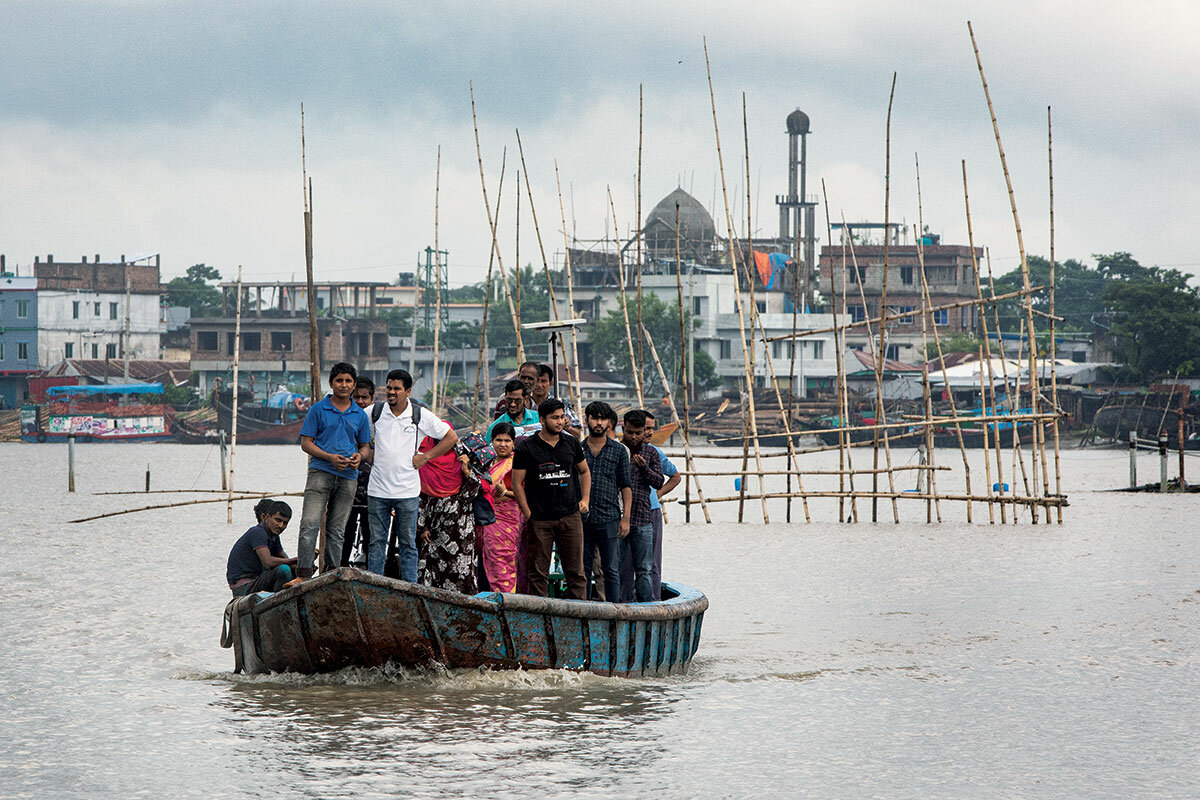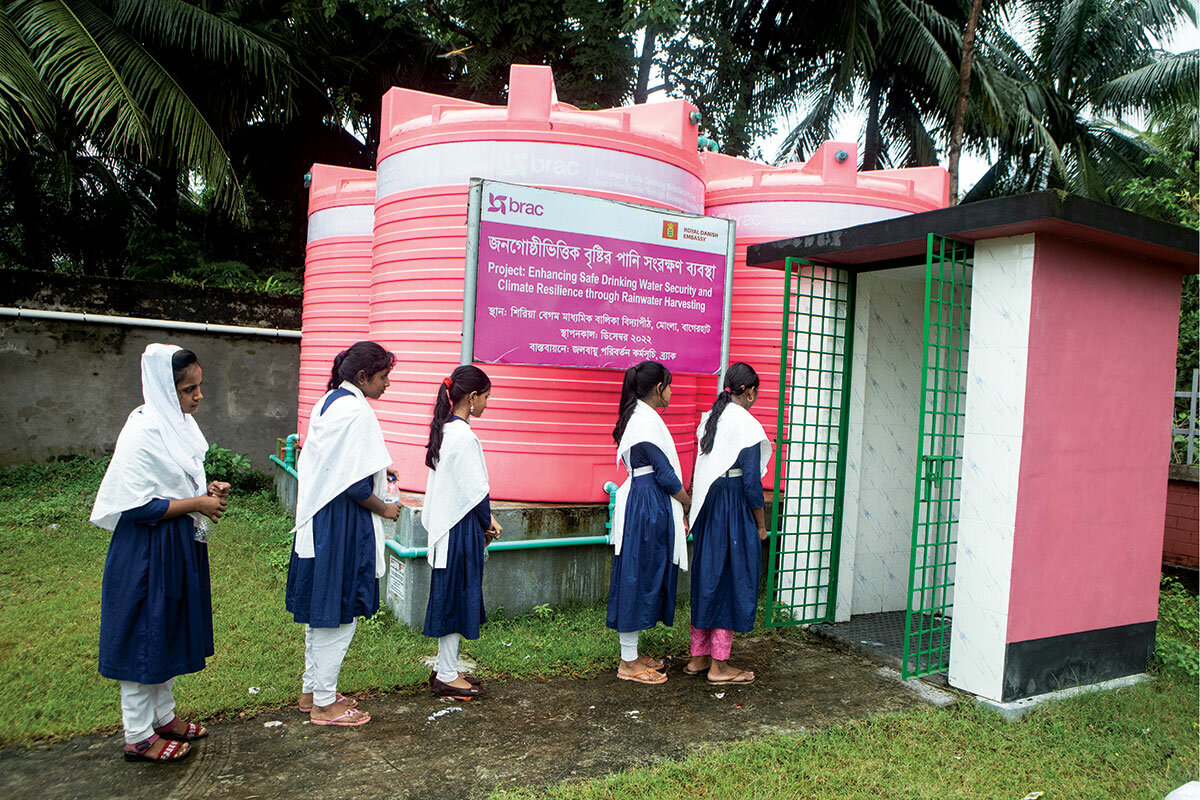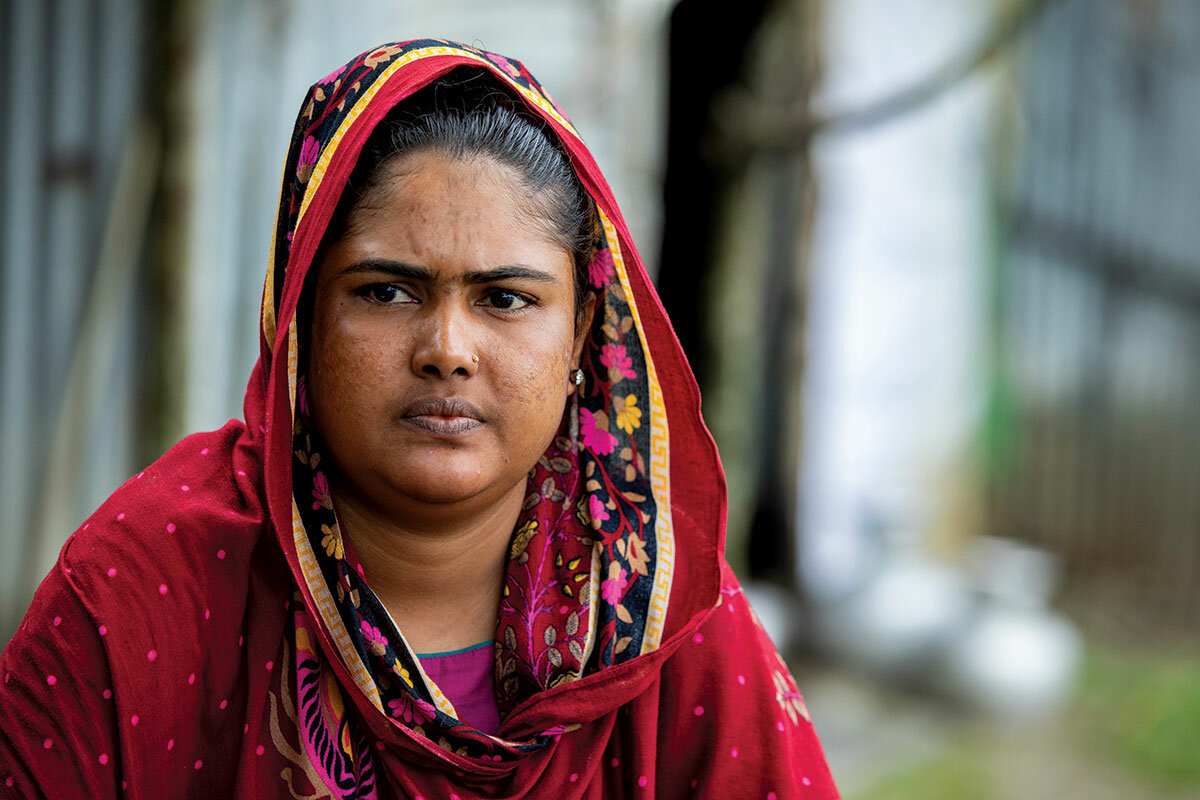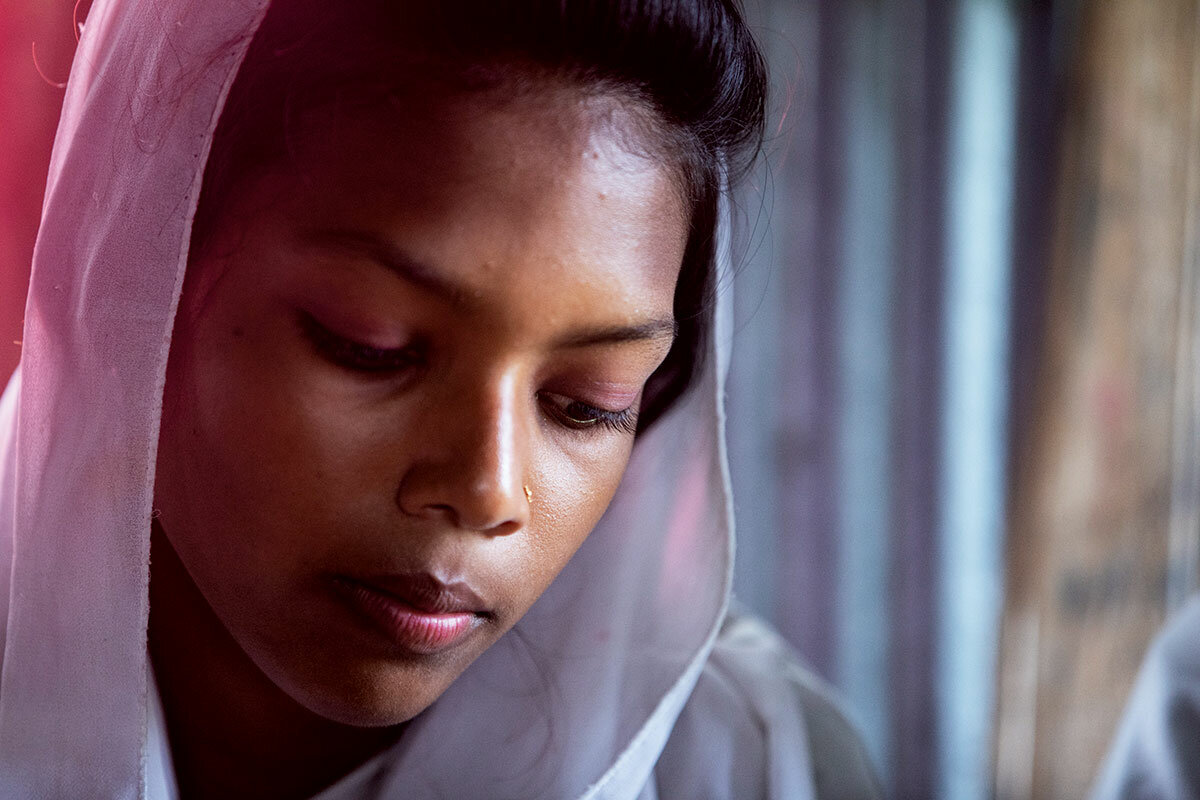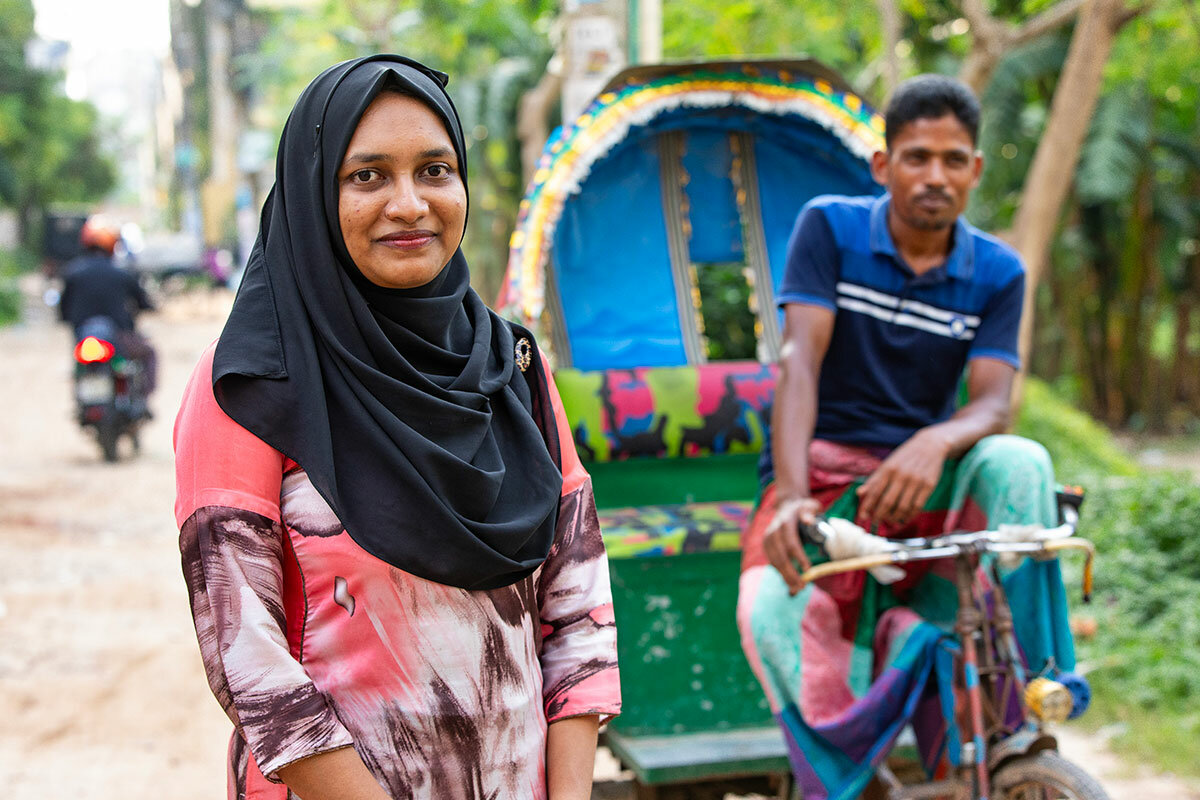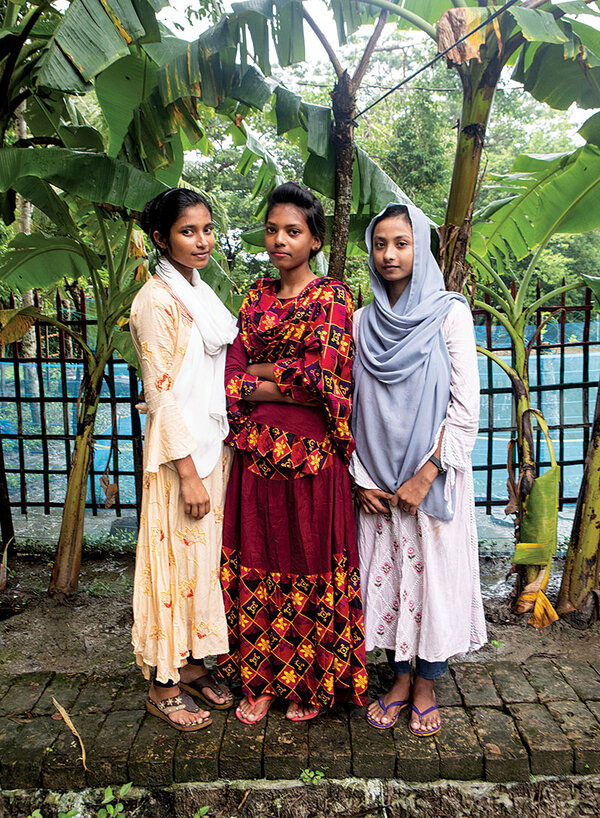On tides of climate change, adaptability buoys hope
Loading...
| Dhaka, Sarankhola, and Mongla, Bangladesh
Water is never in balance in Bangladesh, where rivers flowing from the Himalayas converge in the world’s largest delta. That makes children like 11-year-old Lamia Akter among the world’s most vulnerable in the face of climate change.
But she’s also a climate adapter.
Down an alleyway no wider than 3 feet, in one of Dhaka’s thousands of teeming informal settlements, is a bright little schoolroom filled with tiny wooden tables.
Why We Wrote This
A story focused onIn Bangladesh, on the world’s largest delta, the effects of climate change determine where children live, how long they study, and when they will marry. Resilience is their hope. Part 3 in a seven-part series.
When the teacher asks the students – ages 8 to 14 – if they know what climate change is, Lamia is too timid to answer. So she lets other small voices blurt out: “Floods!” “Cyclones!” But – as one of an estimated 2,000 climate migrants arriving in this capital city every day – she knows the answer better than anyone. Her family home on the northern flood plains of Kishoreganj was washed away last year, forcing them to move here.
Now, her mother works in a garment factory; her father, once a rice farmer, drives a rickshaw. Back home, where their view looked onto cultivated paddies, annual monsoon floods are commonplace. But flash floods last year, part of a trend of storms bigger and fiercer than the seasonal norm, wiped away their home – a plight thousands of Bangladeshis face amid Himalayan glacier melt, rising sea levels, river erosion, and more erratic rains.
Life is harder now, explains her mother, Shirin Begum, at their Dhaka home. It’s a sweltering single room of corrugated metal, drab save the meticulous line of bright salwar kameez outfits hanging from ropes strung across the walls.
But climate migration has offered an opportunity to her daughter, too.
“I went to school until grade five, and I felt sorrow that I couldn’t do that for my daughter,” says Ms. Begum.
In her late 20s, Lamia’s mom is a beneficiary of the United Nations Convention on the Rights of the Child (UNCRC). The human rights treaty’s protections have transformed childhood around the globe; here, they’ve spurred mass enrollment in primary schools.
But by the time Lamia was born in 2012, the effects of a warming planet were already threatening her right to education: The family couldn’t access a boat necessary, amid prolonged flooding, to get Lamia to school. “I often cried about it,” says her mother.
Both Lamia and her mom are part of what the Monitor, in this global report, is calling the Climate Generation: those born since 1989, when the UNCRC was adopted and when climate change became a part of global consciousness. In August, the U.N. Committee on the Rights of the Child acknowledged that global warming threatens to roll back gains brought about by the treaty – and it underscored that children’s human rights include the right to a clean, healthy, and sustainable environment. The group of experts placed particular attention on the “disproportionate harm faced by children in disadvantaged situations” – children just like Lamia.
Today Lamia is learning to read and write as part of a collaboration among the government, nongovernmental organizations, and UNICEF to help vulnerable children enter the formal education system. And, in a country lauded for its climate resilience, Lamia as a climate migrant is part of a generation whose lives demonstrate the adaptation required to face the crisis.
“Within the climate space, we see a big gap ... because for a long time the dialogue has been that if you’re focused on [doing] mitigation well, you do not need to do adaptation,” says Asif Saleh, executive director of the NGO BRAC. “But we are seeing that that’s irrelevant [now], that even if you do mitigation, you will need to continue to do adaptation because changes are happening on the ground.
“Bangladeshis are adapters, and they will continue to adapt,” says Mr. Saleh, whose organization leads climate adaptation models throughout Bangladesh, “and I do think young people will lead in terms of coming up with good adaptive solutions.”
From entering new schools to forging new awareness in cities like Mongla, which calls itself Bangladesh’s first “climate resilient migrant-friendly town,” this generation is securing its rights even as it comes to terms with how adaptability will be required. It will affect everything from where they’ll live and how long they can study, to when they’ll go to work and when they’ll marry – especially as girls Lamia’s age are newly vulnerable in the impoverishment of climate migration.
“I want [Lamia] to complete her education and to be whatever she wants to be,” says Ms. Begum.
That, says Lamia, resting her head on her mom’s shoulder, might be a teacher.
Her mother adds, “But I wish we didn’t have climate problems, so we’d be at home, so she could have gone to school [there].”
For thousands of years, the easygoing people at the confluence of the Ganges, Brahmaputra, and Meghna rivers have lived with raging floods and tropical storms. A warming planet has made those ancient patterns more erratic and intense for today’s 170 million Bangladeshis.
Climate change could prompt the displacement of 216 million people by 2050, estimates the World Bank – and low-lying Bangladesh and its children are among the world’s most vulnerable to climate-related extremes. By then, the bank concludes, a third of Bangladesh’s agricultural gross domestic product may be lost due to climate variability and extreme events. Today about 3% of the population has been uprooted – but food and water scarcity and rising sea levels are expected to drive that to 12% within 30 years.
The pressures come across the country – bigger floods in the north from glacier melt, rising seas and salinity levels in the southern coastal zone, increased river erosion along the web of 700 waterways that crisscross this nation.
This is forcing thousands of people to Dhaka, one of the fastest-growing megacities in the world, by bus, boat, and bicycle, and on foot. And the Dhaka-based International Centre for Climate Change and Development (ICCCAD) estimates this rapid urbanization is going to get “bigger and bigger.”
All of this can feel theoretical in much of the world. But it’s visible in real time in Bangladesh by simply walking to the eroding edge of a riverbank – like the one that is 12-year-old Jahidul Bepari’s front yard. That’s where he learned to fear cracks in the earth.
Here, in the district of Sarankhola, two hours southeast of the closest sizable city, Mongla, the land along the rivers and channels is in a constant state of increasingly rapid transformation.
Sometimes the impact is stunningly immediate: In 2007, Cyclone Sidr swallowed thousands of homes here, leaving clusters of hyacinths floating in their places today and driving many residents to Mongla. Other times the impact of climate change, on river erosion for example, is a painful, slow-motion process for those on the literal edge, like Jahidul.
The cracking earth, he says, “means something bad is going to happen.” River erosion has caused his family to move twice in his young life – each time rebuilding their simple home with wood and scraps of tin weighted down with bricks, moving each time with the riverbank as it receded. And each time, they got poorer.
His mother points to the site of their first home – now washed away into the middle of the Baleshwar River. The last time his home was swept away, three years ago, he was 9 years old. He remembers the pitch black of night, before bedtime, when floodwater swept into the house and nearly drowned them. “I have trouble sleeping still,” he says.
The family has no more resources to keep Jahidul in school, so he stopped studying after fifth grade, joining his family in fishing the river here that gives them everything – and can take it all away. One day, they know with almost certainty, they will have to leave.
That’s why the government, along with national and international NGOs and the ICCCAD, is trying to forge a new narrative in nearby Mongla – that climate migration itself can be seen as an act of adaptation, a proactive choice in the face of reality instead of a traumatic uprooting that marginalizes the family and child.
Creating that narrative of adaptation in Mongla involves engineering a new “social-cultural construct” – a new mindset foundation, as Saleemul Huq, the late director of the ICCCAD, put it in a Monitor interview earlier this year. And the younger generation is where that can take root most solidly, he emphasized.
Mongla is managing that thought shift in small and large ways. The city aims to attract climate migrants, seeing them as a feeder of the economy, rather than a drag on it. And it announces its intentions boldly, with hot-pink rain-collecting tanks. They cheerfully punctuate the landscape in a visual advertisement of the effort to sustainably provide clean water to the growing population. Locals joke that their port city is “turning pink” in the effort to be a model of adaptability as the nation’s first climate-resilient, migrant-friendly town.
The tanks are as much PR as a solution to the rising salinity levels of fresh water. Making the nation’s population both aware of the challenge to source enough drinking water and able to adapt to it is the first part of a strategy to relieve climate migration pressure on the nation – the world’s eighth-most populated in an area about the size of Iowa.
A community that has adapted to climate-related pressures, the reasoning goes, will welcome new migrants without a scarcity mindset taking over, explained Dr. Huq, who died unexpectedly just before press time.
And young people are key to this, he said. One idea floated here is to offer scholarships to schoolchildren to incentivize families to move here, relying on young people to be the natural ambassadors of coexistence.
Forging a “migrant-friendly” city is a top-down and bottom-up approach, Mongla Mayor Sheikh Abdur Rahman explains. The job of the city, at the edge of the Sundarbans, a UNESCO-protected mangrove forest, is to create jobs and protect them in the face of climate change.
Mongla’s population has expanded to 150,000 alongside the industry that has grown here since a port was built in the 1950s. Thousands cross the Pashur channel daily on flat wooden boats by which commuters reach jobs in garment factories in the business export zone. The city has completed infrastructure like flood-protection embankments, floodgates, and better drainage systems as it faces increasing floods.
The grassroots water management efforts are led by a constellation of NGOs, academics, agencies, and donors fostering climate awareness and adaptive behavior so families can stay put.
On a recent afternoon, students at the all-girls Shiria Begum secondary school line up for water at its pink tank installed by BRAC. Without rainwater harvesting, the water that families collect in clay pots at their homes often dries out in the dry season. Then they’re forced to buy pond water, which student Mafiya Khatun says, scrunching her nose, is “disgusting.”
An eighth grader, Mafiya learned in science class that, by 2050, a fifth of Bangladesh will be underwater. “That scares me,” she says. “It makes me sad.”
That pink tank at Mafiya’s school is one of 26 set up at public centers and over 5,000 more at homes across Mongla in the past year. BRAC aims to serve 67,000 individuals in Mongla – up from 12,000 today – by the end of 2024.
The work is also that of changing mindsets. BRAC and the Global Center on Adaptation are establishing “locally led adaptation” committees in the 20 most vulnerable communities of Mongla. Each committee, composed of 60% women, also has one youth representative to help identify the community’s needs and drive change.
At an informal settlement of 60 homes at the edge of the Pashur River, committee youth member Fahima Begum says her community chose to excavate an old pond about the size of a soccer field. The project is not for aquaculture, an industry that has increased salinity problems amid the labyrinth of ponds and channels of Mongla, but so residents can collect enough rainwater for household cleaning.
They’ve also recently installed a rainwater harvesting system that will have the biggest impact on women and girls, she says. Doctors are telling women about studies suggesting that salinity causes reproductive problems, Ms. Begum says matter-of-factly. And high schooler Fatema Akhter says she sometimes has to walk 3 miles to access clean water.
Ms. Begum, who is 24, sees young people like herself as key to the changes underway in her community: “Young people are able to accept change more easily than elders,” she says, “and we can communicate changes faster.”
Indeed, pupils at Mafiya’s school already demonstrate adaptation, says Khadeja Parvin, who teaches the chapter on climate change impact. If their parents are learning new techniques, such as how to store rainwater, for their children it’s simply the way of doing things now, explains Ms. Parvin – at age 34, a member of her students’ generation.
“It’s easy for them to understand because they are living it every day,” she says. “They can adapt because they understand the facts.”
If Lamia or Jahidul were to become her peers in Mongla, Mafiya says she’d welcome them.
Many of the climate migrants who have found their way to Dhaka have to fight for their right to a full childhood – one in which they can study as long as they want, without having to supplement family income.
According to UNICEF, net primary school attendance shot up from 65% in 1990 – when Bangladesh ratified the UNCRC – to 86% in 2019. It’s one of the clearest gains in children’s well-being in Bangladesh – but it’s also the one most clearly threatened by climate change, says Emma Brigham, deputy representative for UNICEF Bangladesh.
The year 1990 also marks the first time that the impact of climate change on human migration was identified in the U.N.’s Intergovernmental Panel on Climate Change – the world’s guidance for governmental climate policies. The panel suggested that the greatest single impact of climate change could be forced migration – with millions of people displaced by shoreline erosion, coastal flooding, and agricultural disruption. And many around the world are concerned that today’s climate migration – to or from anywhere – is making children’s lives more precarious in the face of poverty and the ongoing fallout from the pandemic.
At a protection center in a neighborhood of Dhaka known as “burnt slum” that looks out onto an old landfill, children, including some newly arrived migrants, are singing a song on a recent day. Begun in 2021, hubs like this one are raising awareness of human rights, building community bonds, and using government databases that administrators believe are preventing hundreds of cases of child marriage and illegal or hazardous child labor each month, UNICEF says.
Of 35 children who eat meals and get lessons here, 27 have jobs such as collecting garbage or working in tile or garment factories, says Shaikh Reshma, child rights facilitator for the Ministry of Women and Children’s Affairs, which runs the center with support from UNICEF. She says that for families, having children work “is a choice of impossible choices to be made.”
Climate change and migration intensify these choices of how to maintain livelihoods, says UNICEF’s Ms. Brigham. “That’s where a coping mechanism such as marrying your daughter off becomes a requirement. Climate vulnerability areas ... overlay very clearly with higher rates of child marriage.”
The displacement of children is what spurred the activism of 25-year-old Farzana Faruk Jhumu, who since 2022 has been a UNICEF Bangladesh youth advocate.
She never intended to be a climate activist. Before the pandemic, she was brainstorming with her siblings and friends about how to make a difference in their community. In 2019, full of young idealism, they decided to start an informal “classroom” in an informal settlement, 10 minutes from their home.
Three months in, a new girl appeared – a climate migrant just like Lamia, who lives in the same part of Dhaka. She told them she’d just arrived from the coastal south because a flood forced her family from their home. Ms. Jhumu started noticing a trend, and how, for children, climate migration was exacerbating the many problems that inspired her to help them in the first place.
“Everybody knows that climate change exists. We see it every day, every month, every year,” she says. “But that idea that it’s not all about planting trees or plastic pollution, that is what I learned. ... We need to talk about intersectionality, how women [and children] are more impacted.”
Today she is one of the country’s most recognized young climate activists, and she travels to climate conferences around the globe as a youth advocate. Her message centers on her country’s resilience – particularly that of its children, poised to face the crisis because of the rights they’ve garnered.
When the gong signals the end of the school day, Mafiya heads to an after-school club, taking a treacherous hopscotch on bricks scattered over slick mud. There she meets up with Muntarin Jaman, a fellow eighth grader, and 19-year-old Sanjida Akhter. The club aims to teach Bangladeshi children about key issues they confront in daily life. It introduces awareness of climate science and legal rights around dangerous and exploitative child labor and child marriage. And it includes such subjects as the etiquette of looking people in the eye to make social interaction more civil and the hygiene of washing hands often.
They’re best friends. They paint their hands with henna and write Bangla lyrics in the folk style of rural scroll narrative music to express their young thoughts. They don’t have cellphones, but sometimes they borrow their teacher’s to listen to Bollywood music and make up dance routines.
A pouring rain thunders off the tin roof that covers the one-room children’s center run by the NGO CODEC, which works on community development across coastal Bangladesh. Inside, about two dozen students perform a song they penned for last year’s World Environment Day.
“Lots of meetings and seminars, everyone is busy. Giving speeches on this World Environment Day is so easy, but who thinks of doing something practical?” a girl belts before all the children join in the refrain. “Let’s come, join, and do something for the environment!”
It comes out off-key: Muntarin puts her head, embarrassed, on Mafiya’s shoulder, and the two giggle.
They’re learning about how climate change intersects with their lives as a magnifier of the day-to-day problems closest to their hearts. Climate change intensifies the rain that falls through the roof on Sanjida’s head while she sleeps; it’s the reason they drink rainwater; it animates their seriousness about cyclone protocols.
Sanjida explains that some women in her community refuse to go to the cyclone shelter next to their house – the local primary school – because of traditional beliefs about dying anywhere but on their father’s or husband’s land.
But instead, some of those women are beginning to embrace the life-or-death importance of heading to a safe shelter. This includes learning how the nation’s advance warning system works and how to prepare for a cyclone – including tying up their hair, gathering medications, and putting valuables in a barrel and burying them.
Mafiya boasts proudly that she convinced her family – including her grandmother – to head to the shelter for the first time when a cyclone was forecast in May.
They’ve also learned about the intersections of their rights and climate change, particularly the domino effect it has on very personal aspects of their lives, such as when they marry.
Sanjida’s two elder sisters were married at 14 and 16. A few years ago, her father, who works as a day laborer wherever he can, brought up the subject of her own marriage. She says that pressure is in part because the family can’t grow its own food in the saline earth. Still, she told her parents she wasn’t interested.
“They haven’t brought it up again for now,” says Sanjida, who makes sure to add to all listening that, in fact, she never wants to get married.
“When children marry early, they face complications during pregnancy; their education gets hampered; they are deprived of their childhood and the love of their families,” says Mafiya, her serious words incongruent with her schoolgirl giggle. “Climate change is related because it makes people poor, and girls are seen as one more burden in the house.”
While it’s not possible statistically to show a direct link between climate change and child marriage at the societal level, experts increasingly try to draw one at the grassroots. A recent study published in the journal International Social Work linked droughts, floods, and other extreme weather events to early and forced marriages. In Bangladesh, marriage increased by 50% among girls between the ages of 11 and 14 in years with heat waves, researchers found.
The prevalence of marriage here among girls under age 18 stands at 51%, one of the highest rates in the world. But it was over 80% in 1990, when Bangladesh ratified the UNCRC. That means that, if these girls had been born before then, they very well might be married right now, says Mafiya. Her grandmother married at age 12. Her stepmother, Nipu Begum, who is raising her, married at 15.
One day after school, her stepmom concedes that Mafiya’s education is not her top concern. Her priorities are accessing clean drinking water to prevent her five children, the youngest still a baby, from getting diarrhea, waterborne illnesses, and the reproductive problems believed to be connected to contaminated water.
Still, like Lamia’s mother in a one-room home north in Dhaka, she supports Mafiya’s ideas. “I want her to do whatever it takes, however long she wants to study, and whatever is good for her future.”
To Mafiya, a good future means having enough food, clothes, education, health, and rights to participate in decision-making – all in a clean and safe environment, ideally right here in Mongla.
In other words, she wants all the rights guaranteed to her under the UNCRC. For that, she must be a climate adapter, and she welcomes others to adapt alongside her community in Mongla. Her reasoning is simple: “It would be saving lives.”
After all, that’s her ultimate dream, at the heart of her idea of progress.
Mafiya wants to become a doctor. So does Muntarin. Sanjida wants to become a nurse. They are the youngest cohort of the Climate Generation.






